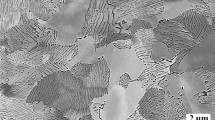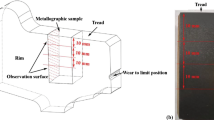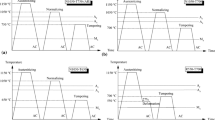Abstract
In this work, the relationship between rolling contact fatigue (RCF) failure and the microstructure of D2 wheel steel was studied using a GPM-30 fatigue tester under oil lubrication conditions. The microstructural evolution during the RCF process can be divided into three stages: In the first stage, the misorientation of the proeutectoid ferrite is 2°–10°, the ferrite phase in pearlite is less than 2°, and the dislocation density is low. In the second stage, with the increase in cycles, the misorientation of the proeutectoid ferrite increases to more than 10°, and the ferrite phase in pearlite increases to 2°–10°. In the third stage, the misorientation of the ferrite phase in pearlite increases to more than 10°, the ferrite phase is divided into fine grains, and the dislocation density is high. RCF cracks are formed in the third stage. Crack initiation is ascribed to the refinement of the surface ferrite phase and proeutectoid ferrite and the increase in dislocation density. RCF cracks are initiated and propagate primarily at the interface of pearlite/proeutectoid ferrite and in proeutectoid ferrite.














Similar content being viewed by others
References
Ekberg, A., Kabo, E.: Fatigue of railway wheels and rails under rolling contact and thermal loading: an overview. Wear 258, 1288–1300 (2005)
Bevan, A., Molyneux-Berry, P., Eickhoff, B., Burstow, M.: Development and validation of a wheel wear and rolling contact fatigue damage model. Wear 307, 100–111 (2013)
Makino, T., Kato, T., Hirakawa, K.: The effect of slip ratio on the rolling contact fatigue property of railway wheel steel. Int. J. Fatigue. 36, 68–79 (2012)
Seo, J.W., Jun, H.K., Kwon, S.J., Lee, D.H.: Rolling contact fatigue and wear of two different rail steels under rolling-sliding contact. Int. J. Fatigue. 83, 184–194 (2016)
Tatsumi, K., Mineyasu, T., Minoru, H.: Development of SP3 rail with high wear resistance and rolling contact fatigue resistance for heavy haul railway. JFE. Technol. Rep. 16, 32–37 (2011)
Kapoor, A., Franklin, F., Wong, S.K., Ishida, M.: Surface roughness and plastic flow in rail wheel contact. Wear 253, 257–264 (2002)
Masoumi, M., Ariza, E.A., Sinatora, A., Goldenstein, H.: Role of crystallographic orientation and grain boundaries in fatigue crack propagation in used pearlitic rail steel. Mater. Sci. Eng. A. 722, 147–155 (2018)
Hu, Y., Su, C.R., Guo, L.C., Liu, Q.Y., Guo, J., Zhou, Z.R., Wang, W.J.: Effect of rolling direction on microstructure evolution of CL60 wheel steel. Wear 424–425, 203–215 (2019)
Lv, B., Zhang, M., Zhang, F.C., Zheng, C.L., Feng, X.Y., Qian, L.H., Qin, X.B.: Micro-mechanism of rolling contact fatigue in Hadfield steel crossing. Int. J. Fatigue. 44, 273–278 (2012)
Santa, J.F., Cuervo, P., Christoforou, P., Harmon, M., Beagles, A., Toro, A., Lewis, R.: Twin disc assessment of wear regime transitions and rolling contact fatigue in R400HT-E8 pairs. Wear 432–433, 102916 (2019)
Li, Q., Guo, J., Zhao, A.M.: Effect of upper bainite on wear behavior of high-speed wheel steel. Tribol. Lett. 67, 121 (2019)
Hardwick, C., Lewis, R., Stock, R.: The effects of friction management materials on rail with pre-existing RCF surface damage. Wear 384, 50–60 (2017)
Wang, S.S., Zhao, X.J., Liu, P.T., Pan, J.Z., Chen, C.H., Ren, R.M.: Investigation of the relation between rolling contact fatigue property and microstructure on the surface layer of D2 wheel steel. Mater. Sci. Appl. 10, 18 (2019)
Ministry of Industry: Ministry of industry and information technology of the People's Republic of China. YB/T5345-2014, pp. 1–23. Rolling contact fatigue test method for metal materials. Metallurgical Industry Press, Beijing (2014)
Linz, M., Cihak-Bayr, U., Trausmuth, A., Scheriau, S., Künstner, D., Badisch, E.: EBSD study of early-damaging phenomena in wheel–rail model test. Wear 342–343, 13–21 (2015)
Kubin, L.P., Mortensen, A.: Geometrically necessary dislocations and strain-gradient plasticity: a few critical issues. Scr. Mater. 48, 119–125 (2003)
Gao, H., Huang, Y., Nix, W.D., Hutchinson, J.W.: Mechanism-based strain gradient plasticity—I Theory. J. Mech. Phys. Solids. 47, 1239–1263 (1999)
Izotov, V.I., Pozdnyakov, V.A., Lukyanenko, E.V., Yu, O., Sanova, U., Filippov, G.A.: Influence of the pearlite fineness on the mechanical properties, deformation behavior, and fracture characteristics of carbon steel. Phys. Met. Metallogr. 103, 519–529 (2007)
Tao, N.R., Wang, Z.B., Tong, W.P., Sui, M.L., Lu, J., Lu, K.: An investigation of surface nanocrystallization mechanism in Fe induced by surface mechanical attrition treatment. Acta Mater. 50, 4603–4616 (2002)
Petch, N.: The cleavage strength of polycrystals. Iron Steel Inst. 174, 25–28 (1953)
Busby, J.T., Hash, M.C., Was, G.S.: The relationship between hardness and yield stress in irradiated austenitic and ferrite steels. J. Nucl. Mater. 336, 267–278 (2005)
Liu, C.M., Wang, J.J., Lin, R.R., Cui, W.F., Bai, Y.G.: Role of small amounts of carbon in fine grain strengthening of steels. Mater. Sci. Technol. 9, 301–304 (2001). (Chinese)
Li, Q., Zhang, C., Chen, H., Chen, H., Yang, Z.G.: Microstructural evolution of a hypoeutectoid pearlite steel under rolling-sliding contact loading. J. Iron. Steel. Res. Int. 23, 1054–1060 (2016)
Garnham, J.E., Davis, C.L.: The role of deformed rail microstructure on rolling contact fatigue initiation. Wear 265, 1363–1372 (2008)
Urashima, C., Nishida, S.: Fatigue crack initiation and propagation behavior in pearlite structures, Fatigue'96. Sixth Int. Fatigue Congr. 1, 319–324 (1996)
Lu, K.: Marking strong nanomaterials ductile with gradients. Science 345, 1455–1456 (2014)
Eden, H.C., Garnham, J.E., Davis, C.L.: Influential microstructural changes on rolling contact fatigue crack initiation in pearlitic rail steels. Mater. Sci. Technol. 21, 623–629 (2005)
Knothe, K., Liebelt, S.: Determination of temperatures for sliding contact with applications for wheel-rail systems. Wear 189, 91–99 (1995)
Franklin, F.J., Kapoor, A.: Modeling wear and crack initiation in rails. Proc. Inst. Mech. Eng. F 221, 23–33 (2007)
Fletcher, D.I., Hyde, P., Kappor, A.: Modelling and full-scale trials to investigate fluid pressurization of rolling contact fatigue cracks. Wear 265, 1317–1324 (2008)
Bogdanski, S., Olzak, M., Stupnicki, J.: Numerical stress analysis of rail rolling contact fatigue cracks. Wear 191, 14–24 (1996)
Acknowledgements
This research was supported by the National Key Basic Research Program of China (No. 2015CB654802).
Author information
Authors and Affiliations
Corresponding author
Additional information
Publisher's Note
Springer Nature remains neutral with regard to jurisdictional claims in published maps and institutional affiliations.
Rights and permissions
About this article
Cite this article
Liu, Cp., Ren, Rm., Liu, Dy. et al. An EBSD Investigation on the Evolution of the Surface Microstructure of D2 Wheel Steel During Rolling Contact Fatigue. Tribol Lett 68, 47 (2020). https://doi.org/10.1007/s11249-020-1277-1
Received:
Accepted:
Published:
DOI: https://doi.org/10.1007/s11249-020-1277-1




